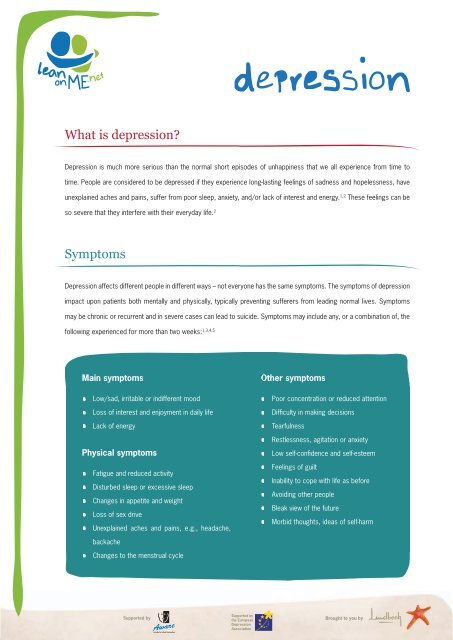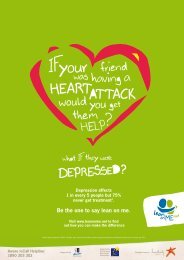What is depression? Symptoms - Lean on Me
What is depression? Symptoms - Lean on Me
What is depression? Symptoms - Lean on Me
Create successful ePaper yourself
Turn your PDF publications into a flip-book with our unique Google optimized e-Paper software.
<str<strong>on</strong>g>What</str<strong>on</strong>g> <str<strong>on</strong>g>is</str<strong>on</strong>g> <str<strong>on</strong>g>depressi<strong>on</strong></str<strong>on</strong>g>?<br />
Depressi<strong>on</strong> <str<strong>on</strong>g>is</str<strong>on</strong>g> much more serious than the normal short ep<str<strong>on</strong>g>is</str<strong>on</strong>g>odes of unhappiness that we all experience from time to<br />
time. People are c<strong>on</strong>sidered to be depressed if they experience l<strong>on</strong>g-lasting feelings of sadness and hopelessness, have<br />
unexplained aches and pains, suffer from poor sleep, anxiety, and/or lack of interest and energy. 1,2 These feelings can be<br />
so severe that they interfere with their everyday life. 2<br />
<str<strong>on</strong>g>Symptoms</str<strong>on</strong>g><br />
Depressi<strong>on</strong> affects different people in different ways – not every<strong>on</strong>e has the same symptoms. The symptoms of <str<strong>on</strong>g>depressi<strong>on</strong></str<strong>on</strong>g><br />
impact up<strong>on</strong> patients both mentally and physically, typically preventing sufferers from leading normal lives. <str<strong>on</strong>g>Symptoms</str<strong>on</strong>g><br />
may be chr<strong>on</strong>ic or recurrent and in severe cases can lead to suicide. <str<strong>on</strong>g>Symptoms</str<strong>on</strong>g> may include any, or a combinati<strong>on</strong> of, the<br />
following experienced for more than two weeks: 1,3,4,5<br />
Main symptoms<br />
Low/sad, irritable or indifferent mood<br />
Loss of interest and enjoyment in daily life<br />
Lack of energy<br />
Physical symptoms<br />
Fatigue and reduced activity<br />
D<str<strong>on</strong>g>is</str<strong>on</strong>g>turbed sleep or excessive sleep<br />
Changes in appetite and weight<br />
Loss of sex drive<br />
Unexplained aches and pains, e.g., headache,<br />
Other symptoms<br />
Poor c<strong>on</strong>centrati<strong>on</strong> or reduced attenti<strong>on</strong><br />
Difficulty in making dec<str<strong>on</strong>g>is</str<strong>on</strong>g>i<strong>on</strong>s<br />
Tearfulness<br />
Restlessness, agitati<strong>on</strong> or anxiety<br />
Low self-c<strong>on</strong>fidence and self-esteem<br />
Feelings of guilt<br />
Inability to cope with life as before<br />
Avoiding other people<br />
Bleak view of the future<br />
Morbid thoughts, ideas of self-harm<br />
backache<br />
Changes to the menstrual cycle<br />
Supported by<br />
Supported by<br />
the European<br />
Depressi<strong>on</strong><br />
Associati<strong>on</strong><br />
Brought to you by
Prevalence<br />
Depressi<strong>on</strong> <str<strong>on</strong>g>is</str<strong>on</strong>g> very comm<strong>on</strong>, affecting about 151 milli<strong>on</strong> people worldwide and <strong>on</strong>e in five people in Ireland. 6 The prevalence<br />
of <str<strong>on</strong>g>depressi<strong>on</strong></str<strong>on</strong>g> <str<strong>on</strong>g>is</str<strong>on</strong>g> 50% higher for women than men, but women are also more likely to be treated for the c<strong>on</strong>diti<strong>on</strong> as they<br />
are more likely to seek professi<strong>on</strong>al help. 7,8 The gender difference in treatment rates tends to d<str<strong>on</strong>g>is</str<strong>on</strong>g>appear in the elderly,<br />
although the elderly c<strong>on</strong>tinue to be at high r<str<strong>on</strong>g>is</str<strong>on</strong>g>k of <str<strong>on</strong>g>depressi<strong>on</strong></str<strong>on</strong>g>. 4<br />
Although <str<strong>on</strong>g>depressi<strong>on</strong></str<strong>on</strong>g> <str<strong>on</strong>g>is</str<strong>on</strong>g> comm<strong>on</strong>, it <str<strong>on</strong>g>is</str<strong>on</strong>g> often underestimated and m<str<strong>on</strong>g>is</str<strong>on</strong>g>understood by the public. Stigma creates a str<strong>on</strong>g<br />
barrier both to diagnos<str<strong>on</strong>g>is</str<strong>on</strong>g> and treatment and may perpetuate feelings of <str<strong>on</strong>g>is</str<strong>on</strong>g>olati<strong>on</strong> by those experiencing <str<strong>on</strong>g>depressi<strong>on</strong></str<strong>on</strong>g><br />
resulting in patients failing to seek help because of fear and shame about their d<str<strong>on</strong>g>is</str<strong>on</strong>g>ease. 4,8<br />
People with pers<strong>on</strong>al experience of <str<strong>on</strong>g>depressi<strong>on</strong></str<strong>on</strong>g> 9<br />
Ever experienced pers<strong>on</strong>ally<br />
All adults<br />
Youth/teens<br />
15<br />
31<br />
Youth/teens<br />
29<br />
38<br />
39<br />
33<br />
Unemployed<br />
20<br />
23<br />
Unemployed<br />
22<br />
30<br />
38<br />
37<br />
Older people/aging<br />
9<br />
24<br />
Older people/aging<br />
11<br />
10<br />
2<br />
9<br />
<strong>Me</strong>n<br />
13<br />
11<br />
<strong>Me</strong>n<br />
8<br />
11<br />
13<br />
9<br />
Women<br />
14<br />
17<br />
Women<br />
7<br />
9<br />
13<br />
5<br />
Parents<br />
3<br />
9<br />
Parents<br />
5<br />
3<br />
-<br />
- 2<br />
Full time workers<br />
0<br />
-<br />
7<br />
2008<br />
2009<br />
2010<br />
Full time workers<br />
0 4<br />
3<br />
- 1<br />
2008<br />
2009<br />
2010
Social and ec<strong>on</strong>omic c<strong>on</strong>sequences<br />
As the incidence of <str<strong>on</strong>g>depressi<strong>on</strong></str<strong>on</strong>g> r<str<strong>on</strong>g>is</str<strong>on</strong>g>es, it <str<strong>on</strong>g>is</str<strong>on</strong>g> <strong>on</strong> the verge of becoming globally <strong>on</strong>e of the most debilitating d<str<strong>on</strong>g>is</str<strong>on</strong>g>eases th<str<strong>on</strong>g>is</str<strong>on</strong>g><br />
century. Major <str<strong>on</strong>g>depressi<strong>on</strong></str<strong>on</strong>g> <str<strong>on</strong>g>is</str<strong>on</strong>g> now a leading cause of d<str<strong>on</strong>g>is</str<strong>on</strong>g>ability worldwide with a lifetime prevalence of 16% in the western<br />
world and the most comm<strong>on</strong> mental d<str<strong>on</strong>g>is</str<strong>on</strong>g>order leading to suicide. 4,6,10 It <str<strong>on</strong>g>is</str<strong>on</strong>g> predicted that <str<strong>on</strong>g>depressi<strong>on</strong></str<strong>on</strong>g> at its present rate of<br />
growth, will be the leading cause of burden of global d<str<strong>on</strong>g>is</str<strong>on</strong>g>ease (a measure combining years of life lost due to premature<br />
death and years of life lost due to time lived in states of less than full health) by 2030. 6,11 In additi<strong>on</strong> to the severe clinical<br />
symptoms that <str<strong>on</strong>g>depressi<strong>on</strong></str<strong>on</strong>g> imposes <strong>on</strong> the individual, the ec<strong>on</strong>omic costs to society are extensive:<br />
People suffering from <str<strong>on</strong>g>depressi<strong>on</strong></str<strong>on</strong>g> use 50-75% more healthcare resources than people who are not depressed. 12<br />
Hospital adm<str<strong>on</strong>g>is</str<strong>on</strong>g>si<strong>on</strong>s and healthcare services make up the bulk of the healthcare costs, while the cost of medicati<strong>on</strong><br />
forms a relatively small part. 13<br />
The indirect costs of <str<strong>on</strong>g>depressi<strong>on</strong></str<strong>on</strong>g> are 23 times larger than the cost to the health service, due to lost employment and<br />
productivity. 14<br />
Depressi<strong>on</strong> accounts for 33% of the total cost of brain d<str<strong>on</strong>g>is</str<strong>on</strong>g>orders in Europe, making it the most costly. 15<br />
Onset and cause<br />
Depressi<strong>on</strong> occurs in pers<strong>on</strong>s of all ages, genders, and backgrounds. The neurological causes of <str<strong>on</strong>g>depressi<strong>on</strong></str<strong>on</strong>g> are still<br />
not yet fully understood but it <str<strong>on</strong>g>is</str<strong>on</strong>g> believed that there may be a physiological element to <str<strong>on</strong>g>depressi<strong>on</strong></str<strong>on</strong>g>. 1 The levels of certain<br />
chemical messengers (neurotransmitters) in the brain, including serot<strong>on</strong>in, may play a key role in the development of<br />
<str<strong>on</strong>g>depressi<strong>on</strong></str<strong>on</strong>g>. 16<br />
Depressi<strong>on</strong> can occur independently, or can be triggered by stressful or emoti<strong>on</strong>al situati<strong>on</strong>s where initial normal anxiety<br />
and worry pers<str<strong>on</strong>g>is</str<strong>on</strong>g>ts and develops into prol<strong>on</strong>ged <str<strong>on</strong>g>depressi<strong>on</strong></str<strong>on</strong>g>.<br />
D<str<strong>on</strong>g>is</str<strong>on</strong>g>eases that impair quality of life including heart d<str<strong>on</strong>g>is</str<strong>on</strong>g>ease, stroke, cancer, diabetes, HIV/AIDS and Parkins<strong>on</strong>’s d<str<strong>on</strong>g>is</str<strong>on</strong>g>ease<br />
may also lead to <str<strong>on</strong>g>depressi<strong>on</strong></str<strong>on</strong>g>. 2 A WHO study showed that people with pers<str<strong>on</strong>g>is</str<strong>on</strong>g>tent pain were over four times more likely to<br />
have <str<strong>on</strong>g>depressi<strong>on</strong></str<strong>on</strong>g> than those without pain. 17 Many horm<strong>on</strong>al factors may c<strong>on</strong>tribute to the increased rate of <str<strong>on</strong>g>depressi<strong>on</strong></str<strong>on</strong>g> in<br />
women, such as menstrual cycle changes, pregnancy, m<str<strong>on</strong>g>is</str<strong>on</strong>g>carriage, postpartum period, pre-menopause, and menopause. 2<br />
There <str<strong>on</strong>g>is</str<strong>on</strong>g> some evidence of genetic links for <str<strong>on</strong>g>depressi<strong>on</strong></str<strong>on</strong>g> 2,3 although <str<strong>on</strong>g>depressi<strong>on</strong></str<strong>on</strong>g> <str<strong>on</strong>g>is</str<strong>on</strong>g> also present in people with no family<br />
h<str<strong>on</strong>g>is</str<strong>on</strong>g>tory of the d<str<strong>on</strong>g>is</str<strong>on</strong>g>ease.
Treatment<br />
Most cases of <str<strong>on</strong>g>depressi<strong>on</strong></str<strong>on</strong>g> are treated in the primary care setting by general practiti<strong>on</strong>ers. 4 Despite it being a comm<strong>on</strong> and<br />
debilitating mental d<str<strong>on</strong>g>is</str<strong>on</strong>g>order, <str<strong>on</strong>g>depressi<strong>on</strong></str<strong>on</strong>g> <str<strong>on</strong>g>is</str<strong>on</strong>g> clinically under-recogn<str<strong>on</strong>g>is</str<strong>on</strong>g>ed and undertreated – 30-50% of cases of <str<strong>on</strong>g>depressi<strong>on</strong></str<strong>on</strong>g><br />
are not detected in medical settings. 18<br />
Treatment often involves a combinati<strong>on</strong> of different therapies such as medicati<strong>on</strong>, psychological therapies, social support,<br />
and self-help techniques. An individual’s treatment will depend <strong>on</strong> the severity of their symptoms. Th<str<strong>on</strong>g>is</str<strong>on</strong>g> combined approach<br />
treats the pers<strong>on</strong> as a whole, and marks the beginning of the journey back to wellness.<br />
For further informati<strong>on</strong><br />
For further informati<strong>on</strong> about anxiety and <str<strong>on</strong>g>depressi<strong>on</strong></str<strong>on</strong>g>, please v<str<strong>on</strong>g>is</str<strong>on</strong>g>it:<br />
Aware at www.aware.ie<br />
References<br />
1. Nati<strong>on</strong>al Institute for Health and Clinical Excellence. 2009. Depressi<strong>on</strong>: the treatment and management of <str<strong>on</strong>g>depressi<strong>on</strong></str<strong>on</strong>g> in adults (update). http://guidance.nice.org.uk/CG90.<br />
2. Nati<strong>on</strong>al Institute for <strong>Me</strong>ntal Health. 2007. Depressi<strong>on</strong>. http://www.nimh.nih.gov/publicat/<str<strong>on</strong>g>depressi<strong>on</strong></str<strong>on</strong>g>.cfm#ptdep3.<br />
3. Burcusa and Iac<strong>on</strong>o. 2007. R<str<strong>on</strong>g>is</str<strong>on</strong>g>k for Recurrence in Depressi<strong>on</strong>. Clin Psychol Rev; 27(8): 959–985.<br />
4. The World Health Report. 2001. <strong>Me</strong>ntal Health: New Understanding, New Hope. World Health Organizati<strong>on</strong>. http://www.who.int/whr/2001/en/index.html.<br />
5. The Royal College of Psychiatr<str<strong>on</strong>g>is</str<strong>on</strong>g>ts. 2010. Depressi<strong>on</strong>. http://www.rcpsych.ac.uk/mentalhealthinformati<strong>on</strong>/mentalhealthproblems/<str<strong>on</strong>g>depressi<strong>on</strong></str<strong>on</strong>g>/<str<strong>on</strong>g>depressi<strong>on</strong></str<strong>on</strong>g>.aspx.<br />
6. World Health Organizati<strong>on</strong>. 2008. The global burden of d<str<strong>on</strong>g>is</str<strong>on</strong>g>ease: 2004 update.<br />
7. World Health Organizati<strong>on</strong>. Gender D<str<strong>on</strong>g>is</str<strong>on</strong>g>parities in <strong>Me</strong>ntal Health. http://www.who.int/mental_health/media/en/242.pdf.<br />
8. World Health Organizati<strong>on</strong>. 2002. <strong>Me</strong>ntal health: resp<strong>on</strong>ding to the call for acti<strong>on</strong>. http://apps.who.int/gb/archive/pdf_files/WHA55/ea5518.pdf.<br />
9. Lundbeck (Ireland). 2010. Mind Yourself - Lundbeck <strong>Me</strong>ntal Health Barometer 2010.<br />
10. Kessler et al. 2003.The Epidemiology of Major Depressive D<str<strong>on</strong>g>is</str<strong>on</strong>g>order: Results From the Nati<strong>on</strong>al Comorbidity Survey Replicati<strong>on</strong> (NCS-R). JAMA; 289(23): 3095–3105.<br />
11. World Health Organizati<strong>on</strong>. Global burden of d<str<strong>on</strong>g>is</str<strong>on</strong>g>ease. http://www.who.int/topics/global_burden_of_d<str<strong>on</strong>g>is</str<strong>on</strong>g>ease/en/.<br />
12. Sim<strong>on</strong> et al. 2000. Recovery from <str<strong>on</strong>g>depressi<strong>on</strong></str<strong>on</strong>g>, work productivity, and health care costs am<strong>on</strong>g primary care patients. Gen Hosp Psychiatry; 22(3): 153–162.<br />
13. Berto P et al. 2000. Depressi<strong>on</strong>: cost of-illness studies in the internati<strong>on</strong>al literature, a review. J <strong>Me</strong>nt Health Policy Ec<strong>on</strong>; 3(1): 3–10.<br />
14. Thomas and Morr<str<strong>on</strong>g>is</str<strong>on</strong>g>. 2003. Cost of <str<strong>on</strong>g>depressi<strong>on</strong></str<strong>on</strong>g> am<strong>on</strong>g adults in England in 2000. Br J Psych; 183: 514–519.<br />
15. Sobocki et al. 2006. Cost of Depressi<strong>on</strong> in Europe. J <strong>Me</strong>nt Health Policy Ec<strong>on</strong>; 9(2): 87–98.<br />
16. The Royal College of Psychiatr<str<strong>on</strong>g>is</str<strong>on</strong>g>ts. 2010. Antidepressants. http://www.rcpsych.ac.uk/mentalhealthinformati<strong>on</strong>/mentalhealthproblems/<str<strong>on</strong>g>depressi<strong>on</strong></str<strong>on</strong>g>/antidepressants.aspx.<br />
17. Gureje et al. 1998. Pers<str<strong>on</strong>g>is</str<strong>on</strong>g>tent pain and well-being: a World Health Organ<str<strong>on</strong>g>is</str<strong>on</strong>g>ati<strong>on</strong> study in primary care. JAMA; 280(2): 147–151.<br />
18. Anders<strong>on</strong> et al. 2008. Evidence-based guidelines for treating depressive d<str<strong>on</strong>g>is</str<strong>on</strong>g>orders with antidepressants: A rev<str<strong>on</strong>g>is</str<strong>on</strong>g>i<strong>on</strong> of the 2000 Brit<str<strong>on</strong>g>is</str<strong>on</strong>g>h Associati<strong>on</strong> for Psychopharmacology<br />
guidelines. Psychopharmacol; 22; 343.



